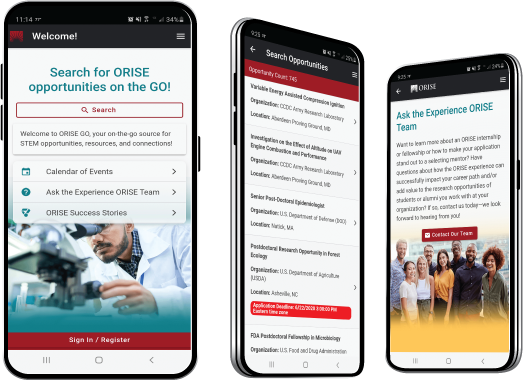Central Bank Digital Currency Technology: the Impact on Global Finance and Implications for National Security
Create and release your Profile on Zintellect – Postdoctoral applicants must create an account and complete a profile in the on-line application system. Please note: your resume/CV may not exceed 3 pages.
Complete your application – Enter the rest of the information required for the IC Postdoc Program Research Opportunity. The application itself contains detailed instructions for each one of these components: availability, citizenship, transcripts, dissertation abstract, publication and presentation plan, and information about your Research Advisor co-applicant.
Additional information about the IC Postdoctoral Research Fellowship Program is available on the program website located at: https://orise.orau.gov/icpostdoc/index.html.
If you have questions, send an email to ICPostdoc@orau.org. Please include the reference code for this opportunity in your email.
Research Topic Description, including Problem Statement:
Members of the BRICS community of states, including Russia, India, China, Iran and UAE, are seeking to establish Central Bank Digital Currencies (CBDCs). Trials of national CBDCs are currently taking place in several BRICS member states. In Russia, the aim is to expand these trials by 2025, with plans to include over 30 banking institutions. The CBDCs will be utilized for cross-border payments within the BRICS community.
It has been confirmed that mBridge, developed in collaboration with the Bank of International Settlements (BIS) and both BRICS and non-BRICS members, has now reached the minimum viable product (MVP) stage. mBridge is being developed to support peer-to-peer and cross-border payments, built on a blockchain platform known as the mBridge Ledger. This blockchain is expected to be compatible with the Ethereum Virtual Machine (EVM), the foundation of the Ethereum network and its decentralized finance system (DeFi). Such compatibility indicates a potential for CBDCs to integrate with the existing cryptocurrency ecosystem.
Reports from blockchain forensics entities confirm the illicit use of cryptocurrency by both state-linked and non-state actors, including serious and organized crime (SOC) groups, cyber criminals, terrorist financiers, and sanctions evaders. Tracing of crypto transactions is possible across most blockchains within the crypto ecosystem; however, it remains unclear whether ledger technology supporting CBDCs will be compatible with current tracing software. Similarly, privacy protocols for CBDCs, particularly regarding user anonymity and pseudonymity, have yet to be established.
There is currently limited academic research on the issues highlighted here. Some publications explore aspects of CBDC architecture such as the security risks in CBDC systems, emphasizing challenges such as de-anonymization through methods like multi-party computations and zero knowledge proofs [1], the privacy trade-offs in CBDC architecture design [2], and the geopolitical implications of a BRICS-led supranational CBDC [3]. However, as CBDCs are an emerging technology, their integration and use by both legitimate and hostile actors is poorly understood. Therefore, research is required to understand the underlying technologies that support CBDCs and to identify current or future methods for tracing these funds within the wider global financial system.
Research should aim to examine potential use cases, their impact on global finance, and how they may be integrated into financial systems. It should also explore the threats and opportunities for hostile actors, including sanctions evaders, SOC groups, cyber criminals, and state-linked actors, to move funds undetected. To understand the evolving landscape of CBDCs, several critical questions must be addressed. With a focus on the BRICS community, what is the current state of CBDCs, including which are currently in use and by whom? What technology underpins them and how do they interact with existing fiat and digital currencies? Are the technologies underpinning the CBDCs compatible with the blockchain technology that currently supports crypto assets? What opportunities exist for tracing transactions across existing and future CBDCs? Additionally, what technological and methodological barriers hinder tracing these transactions, and how do these challenges differ from those associated with established cryptocurrencies?
Example Approaches:
- Investigate how blockchain or similar distributed ledger technologies (DLT) can be integrated into the structure of the CBDCs for adoption by BRICS members.
- Assess the capacity of BRICS CBDCs to connect with the existing crypto asset ecosystem, including an evaluation of the compatibility of the underpinning technologies.
- Explore opportunities for tracking and tracing transactions completed by users of BRICS CBDCs.
References
- Lee Y, Son B, Park S, Lee J, and Jang H. A survey on security and privacy in blockchain-based central bank digital currencies. journal of internet services and information security. 2021;11(3):16-29.
- Auer R, Frost J, Gambacorta L, Monnet C, Rice T, Shin HS. Central bank digital currencies: motives, economic implications and the research frontier. BIS Working Papers 976, Bank for International Settlements.
- Slim A. Will the BRICS be the leaders in central bank digital currencies? Economic Studies Journal, Bulgarian Academy of Sciences - Economic Research Institute, issue 3, pages 3-16.
Key Words: Central bank digital currencies; cryptocurrency; global finance; money laundering; sanctions evasion; serious and organized crime; blockchain
Postdoc Eligibility
- U.S. citizens only
- Ph.D. in a relevant field must be completed before beginning the appointment and within five years of the appointment start date
- Proposal must be associated with an accredited U.S. university, college, or U.S. government laboratory
- Eligible candidates may only receive one award from the IC Postdoctoral Research Fellowship Program
Research Advisor Eligibility
- Must be an employee of an accredited U.S. university, college or U.S. government laboratory
- Are not required to be U.S. citizens
- Citizenship: U.S. Citizen Only
- Degree: Doctoral Degree.
-
Discipline(s):
- Chemistry and Materials Sciences (12 )
- Communications and Graphics Design (3 )
- Computer, Information, and Data Sciences (17 )
- Earth and Geosciences (21 )
- Engineering (27 )
- Environmental and Marine Sciences (14 )
- Life Health and Medical Sciences (45 )
- Mathematics and Statistics (11 )
- Other Non-Science & Engineering (2 )
- Physics (16 )
- Science & Engineering-related (1 )
- Social and Behavioral Sciences (30 )

 ORISE GO
ORISE GO

The ORISE GO mobile app helps you stay engaged, connected and informed during your ORISE experience – from application, to offer, through your appointment and even as an ORISE alum!





